#3D Stereo lenticular
Link
#babushka doll#soviet souvenir#MATRYOSHKA#Soviet BERIOZKA Stores#soviet era#pocket calendar#3D Stereo lenticular#russian doll
0 notes
Text
Demonic Jesus
I’d just moved into an apartment at Carriage Oaks III in Clarkston, Ga.
I walked the blocks surrounding my new apartments taking in my new neighborhood. I’d moved there to be within walking distance to the Clarkston campus of Georgia Perimeter College and I was hoping to find work nearby as well. The population was about half refugees and other immigrants; here were many Somalians, Ethiopians, Eritreans, Kenyans amongst many others. Most bars, restaurants, and gas stations in the area were owned by Eritreans, though there were a number of Korean owned businesses, and at least one bar/restaurant owned by an apparently Eastern European family, the origin of whom I never learned. Most of these businesses were very family oriented, and focused on hiring their owner’s relations and friends as well as members of the owner’s ethnic identity. I ended up working at the text book store near my campus.
But that wasn’t the point of this story. One day while job hunting, I came across what I would describe as a thrift or junk store. The store bore the appearance of an auto garage, with the opening its wide garage doors serving as the main entrance. Inside were shelves built on sawhorses upon which sat the store’s wares; toys, clothing, simple electronics, dish ware, audio and vhs cassettes, etc. Amongst these treasures sat with an ironic appeal was a lenticular print of our lord and savior, Jesus Christ. I’d become a kind of quasi-gnostic atheist by my early 20s and a 3D image of Jesus whose gaze seemed to follow you as you passed was just too odd for me to say no to. I purchased the portrait, took it home and affixed it to my wall above my stereo.
And there it sat. Days later the thrift/junk store disappeared. The space had been sold to a TitleMax.
The portrait was kind of classic, kind and docile white Jesus with copper brown hair and blue eyes. Similar to the coloration of Jesus I’d seen in portraits of Jesus as child in my Mormon upbringing, though with a different, slightly more aquiline and less muscular appearance.
I found absurd amusement in its eyes following me. It was initially disconcerting, but once the phrase “God is always watching.” made it to the surface of my conscious thought, I found my unease silly and viewed the objects maker as being either a devout and paranoid or cynical and manipulative. Guessing at the intent behind the creation of this strange portrait lent it increasing absurdity and an amusing appeal.
Weeks passed. School and work became my focus. This object of amused speculation disappeared into the background of all the other chaotically collected idiosyncratic nonsense.
I’d been up late several nights studying. A less than healthy reliance on caffeine throughout my work and school days would more than occasionally cause me episodes of insomnia. If I had cash, then I’d get drunk in order to sleep. And if I didn’t have cash, then there was an Ethiopian bar, the owner of which, whose name was Esau, would allow me to hold a tab with him. So this was my main strategy for insomnia, but sometimes there was just no affording booze and one simply had to bear with 2-3 days without sleep.
In the midst of an especially sleepless week I sat in the early AM listening classical music on the radio. Light illuminating the common areas of the complex spilled into my living room dimly lighting the others unlit space.
A voice spoke. From where was obscure to me for it didn’t seem to originate from anywhere in space. There was no clear direction identifiable in which I could check. However, I looked out of the window next to my radio as it played classical overtures. No one there. The back door in tiny kitchen which connected to the living room seemed like a contender for the origin of this voice even if it was in the direction opposite my window. Perhaps there was someone at my door? I checked. I opened the door and looked outside. No one there. I looked for a moment longer and listened. No voice. I closed the door and turned around to return to the living room. As I returned to the living room, the voice spoke again. The voice felt deep and churning. Something like rushing water and thunder as it crashed over the the symphony. The words, such as they were, were unintelligible to me. It was something like the experience of being spoken to in another language, the experience of knowing that something is being communicated, something important even, that there is sense and reason in the speech, but being completely unable to assess the meaning.
“What?”, I said.
The voice stopped.
“What? I didn’t understand you.”
I stood still. The statement had seemed profound, but the lack of intelligibility also made it feel empty. Meaningless, like a clever play on words perhaps? A kind of necker cube for intent? Was it this, or that? Nothing?
I returned to where I’d sat earlier listening to the radio, Jesus’ eyes following me there. The overture ended. The announcer’s voice spoke naming the various pieces which had played in the last programming block.
The next block began and I sat.
The voice spoke again.
Meaningless.
#jesus christ#writing#thoughts#easter#psychology#existentialism#mine#autobiography#paranormal#paranoia#insomnia#religion#short story
0 notes
Text
Nishika N8000 35mm Quadrascopic Stereo 3D Lenticular Camera UNTESTED
CAMERA DEALS: Seller: chrilo_286 (99.4% positive feedback)
Location: US
Condition: For parts or not working
Price: 49.99 USD
Shipping cost: Free
Buy It Now https://www.ebay.com/itm/314670918594?hash=item4943d92bc2%3Ag%3A1nQAAOSwAfpkmUeo&mkevt=1&mkcid=1&mkrid=711-53200-19255-0&campid=5338779481&customid=&toolid=10049&utm_source=dlvr.it&utm_medium=tumblr
0 notes
Video
Hand made scratch hologram soon to be available on kickstarter. Contact for more information or visit www.LonGenArt.com
#hologram#scratch#3d#art#design#poster#wallart#specular#star wars#a new hope#death star#light#autostereoscopic#stereo#lenticular#print#3d printing#3d model#cinema 4d#blender#kickstarter
1 note
·
View note
Text
How Lenticular Printing has become a New marketing dimension

Lenticular printing is a new form of technology in which lenticular lenses are used to produce printed images with an illusion of depth.
Effects generally range across:
Animation –From a video clip frames are converted and creates moving print
3D depth
Involving printing on to a transparent clear plastic with an array of optical lens ribs across the surface, lenticular printing is the only specialism in the world. Then on the back of the film images are printed, and they create the moving image when viewed through the optical lens on the front.
Furthermore, to this costly print complex software and pre-press digital artwork preparation has historically made access.
3D Printing from Lenticular Printing Wholesale
Within the brain three-dimensional vision is achieved by merging the image data from the left and right eyes. Such a phenomenon is referred to as parallax. When viewed from slightly different positions it shows the apparent placement of an object relative to its background.
Moreover, a stereoscopic effect is created by the web-based conversion process by converting standard 2D imagery into a multi-layer 3D file. Each lenticule creates a stereo pair when printed onto the reverse side of a lenticular sheet, thus without the need to wear special glasses, it allows the viewer to have a 3D depth effect from various angles.
Flip Printing
Two images are contained in a lenticular effect in its simplest form and it shows to the viewer one at a time as his/her viewing angle to the lens sheets changes. Behind a lenticule, the software automatically interlaces 50% of each image. By the movement of the head to the left, one full image comes into view and then to the right.

However, there is the enormous creative potential of this product from lenticular printing manufacturer, offering you the opportunity to use extreme contrasts of the image to project your promotional message visually.
With personalized communication, we can also combine lenticular print so that your data can drive the message behind the image!
#Lenticular Printing Manufacturer#Lenticular Printing China#Lenticular Printing Supplier#Lenticular Printing
1 note
·
View note
Photo

📸Nimslo. 3D🌌 The Nimslo is a stereo camera with a brightfield viewfinder that produces 3D pictures that can be viewed without glasses. This is done using Lenticular printing. It uses common 35 mm film in 135 film format cartridges. It was produced in the 1980s by Nimstec Atlanta, Georgia, USA. 80’s🇺🇸 follow @concepttalk and @neontalk for more product design. … #80sproduct #nimslocamera #nimslo #80sdesign #iphone11 #80s #80svintage #retrofuture #retrofuturistic #retrofuturism #80sdesign #80style #80saesthetic #retroaesthetic #3dcamera https://www.instagram.com/p/Bss6KImnQPe/?utm_source=ig_tumblr_share&igshid=1c6g2b2fpxphb
#80sproduct#nimslocamera#nimslo#80sdesign#iphone11#80s#80svintage#retrofuture#retrofuturistic#retrofuturism#80style#80saesthetic#retroaesthetic#3dcamera
611 notes
·
View notes
Photo







RFID 3D Lenticular Card, three-dimensional Lenticular Card, 3D Proximity smart Card, 3D stereo effect Print Picture.
http://www.searfid.com/sell-1210773-3d-lenticular-card-three-dimensional-lenticular-card-3d-proximity-smart-card.html
A variety of 3D effect optional. This 3D card is mainly suitable for high-end gifts, Business gifts, VIP card, Membership card, Business card, Wall paintings, Posters, etc.
Size: A2, A3, A4, A5, B2, B3, B4, CR80, optional. CR80 size card can encapsulation RFID chip.
More information, focus: SeabreezeRFID LTD.
W: http://www.SEARFID.com/
E: [email protected]
#RFID 3D Lenticular Card#three-dimensional Lenticular Card#3D Proximity smart Card#3D stereo effect Print Picture#3D stereo effect Print Wall paintings#3D stereo effect Print Picture Posters#3D stereo effect Print Posters#SeabreezeRFID Ltd.
1 note
·
View note
Photo

The Nimslo is a stereo camera with a brightfield viewfinder that produces 3D pictures that can be viewed without glasses. This is done using Lenticular printing. It uses common 35 mm film in 135 film format cartridges. It was produced in the 1980s by Nimstec Atlanta, Georgia, USA @neontalk
11 notes
·
View notes
Text
[Video] The KVB teilen “Unbound”!
Kurz vor der Veröffentlichung ihres neuen Albums "Unity" präsentiert das Underground-Coldwave-Duo The KVB mit dem eindringlichen und euphorischen "Unbound" einen weiteren Vorgeschmack auf den Longplayer, der am 26. November auf Invada erscheint.
Die analoge Ästhetik von Regisseurin Sapphire Goss ergänzt den dunstigen Sound von "Unbound" und erweckt seltsame monolithische Abhörstrukturen entlang der englischen Küste wieder zum Leben. "In fact, they were part of the inspiration for Unity's album cover", erzählen The KVB über die geheimnisvollen Monumente, die einen mysteriösen Mix aus Licht und Farbe aussenden. "It was great to finally visit one in real life, despite the wind and rain that came with filming there." Goss ergänzt: "The film is made using a mix of analogue & digital effects- lenticular 3D & stereo loops shot on an 80s Nimslo (35mm) and an old Mamiya passport lens attachment that freeze moments in time & dance around them spatially, adding to the uncanny feeling.”
youtube
Live:
10.02.2022 Köln - Artheater
11.02.2022 Hamburg - Nochtspeicher
15.02.2022 Berlin - Lido
18.02.2022 Wien (A) - Chelsea Club
21.02.2022 München - Kranhalle
Booking: Puschen
0 notes
Photo
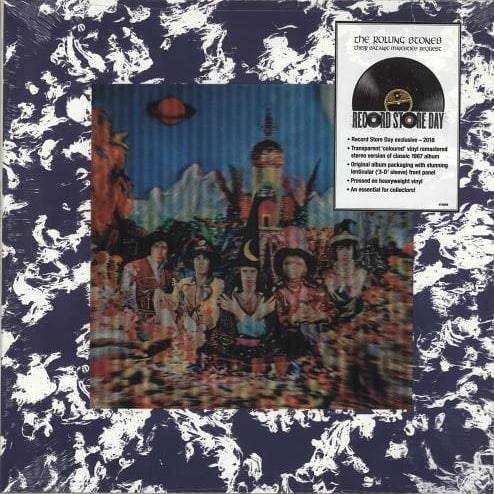
ROLLING STONES Their Satanic Majesties Request. 2018 UK limited edition remastered stereo issue of their classic 1967 album released exclusively for Record Store Day now pressed pressed on 180gram Heavyweight Clear Vinyl, including the singles In Another Land / The Lantern and She's A Rainbow / 2000 Light Years From Home. The vinyl is in BRAND NEW condition housed in the picture sleeve which comes with a 3D Lenticular panel to the front and remains sealed within its hype-stickered original shrinkwrap. Available from https://eil.com/shop/moreinfo.asp?catalogid=694913 #eildotcom #eil #records #vinyl #rarerecords #rarelps #rock #classicrock #cratedigging #vinyljunkie #vinylcollection #recordcollection #vinylporn #instavinyl #rsd #rsd2018 #recordstoreday #rollingstones
#rsd2018#rarelps#vinyl#rsd#rarerecords#rock#instavinyl#classicrock#vinyljunkie#recordstoreday#vinylcollection#eildotcom#rollingstones#cratedigging#eil#recordcollection#vinylporn#records
1 note
·
View note
Link
#soviet era#babushka doll#Matrioshka#russian souvenir#USSR BERIOZKA Stores#Pocket Calendar#collectible#3D Stereo#3D Stereo calendar#3D Stereo lenticular#eBay
1 note
·
View note
Text
Nishika N8000 35mm Quadrascopic Stereo 3D Lenticular Camera
CAMERA DEALS: Seller: stanpom-47 (100.0% positive feedback)
Location: US
Condition: Used
Price: 51.00 USD
Buy It Now https://www.ebay.com/itm/404340619751?hash=item5e249439e7%3Ag%3A~QEAAOSwOAxkdQLB&mkevt=1&mkcid=1&mkrid=711-53200-19255-0&campid=5338779481&customid=&toolid=10049&utm_source=dlvr.it&utm_medium=tumblr
0 notes
Text
Autostereoscopic 3D Display Devices Market Share By Revenue & PEST Analysis by 2017
Global Autostereoscopic 3D Display Devices Market is expected to grow at a significant CAGR in the upcoming years as the scope and its applications are rising enormously across the globe. Autostereoscopic 3D display devices are the devices displaying stereoscopic images without the viewer needing to wear any special glasses or other headgear. Head-tracked autostereoscopic and multitier display combine the effects of both movement parallax and stereo parallax to give 3D effect without glasses. The device comprises of a first light source and a second light source constructed to alternatively generate light.

To achieve the effect of having different images visible on the same plane from different points of view, all autostereoscopic displays use optical components. Manufacturers use technologies like time-sequential, spatial multiplex, and multi-projector to make autostereoscopic displays. Autostereoscopic 3D Display Devices Market is segmented based on types, technology, application, and region. Types such as Multiview Display, Two-View Display, and Head-Tracked Displays classify the market.
Request Sample Copy of This Report @
https://www.millioninsights.com/industry-reports/autostereoscopic-3d-display-devices-market/request-sample
Technology such as Autostereoscopic Content Creation and Conversion, Parallax Barrier, Compressive Light Field Displays, Integral Photography and Lenticular Arrays, and others classify Autostereoscopic 3D Display Devices Market. Applications into Smartphone, Television, and others classify Autostereoscopic 3D Display Devices Industry. Autostereoscopic 3D Display Devices Market is segmented geographically into Americas (North America, Latin America), Europe (Eastern Europe, Western Europe), Asia Pacific, Latin America, Middle East and Africa.
Browse Full Research Report @
https://www.millioninsights.com/industry-reports/autostereoscopic-3d-display-devices-market
Globally, Asia Pacific accounts for the largest market share of Autostereoscopic 3D Display Devices Industry and is estimated to lead the overall market in the years to come. The reason being, rising consumer need for a developed imaging. China and India are the major consumers of the market in this region. The key players of Autostereoscopic 3D Display Devices Market are Dimenco, Sharp, Toshiba, Samsung, and LG. These players are concentrating on inorganic growth to sustain themselves amongst fierce competition. As such, mergers, acquisitions, and joint ventures are the need of the hour.
0 notes
Text
Intro to blog & Nishika N9000 camera review

Hello everyone! Welcome to my very first blog post. I have big plans for this far-flung little corner of the internet: camera reviews, photo techniques, experiments in visual storytelling and more! Art, design, filmmaking, photography - all here. Let’s roll! (no pun or reference to 35mm film intended)
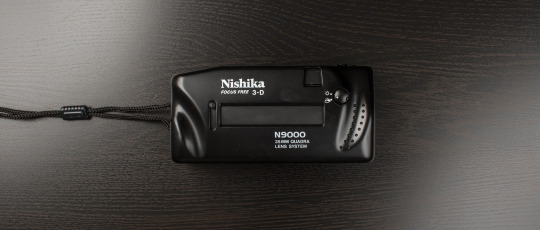
Intro
Today it’s all about photography - I’ll be taking a look at a rather obscure little imaging device - the Nishika N9000. A unique, highly specialized stereo camera that that takes 4 images at the same time from slightly different angles, which, when combined into an animation, create a miniature Matrix-like effect of the objects in the shot appearing three-dimensional. It’s a specialized camera and the only reason you use it is for its GIF-making capability. It is also a complete pain to use, totally unreliable and makes pictures of horrendous quality. Despite all this, it is a total blast and very fun. Read on to find out why.
This camera, along with the original Nimslo and the direct predecessor Nishika N8000 are responsible for the influx of countless animated GIFs on Tumblr, FFFFOUND! and other image blogs alike. I always found them a gleefully enjoyable exercise in lowbrow picture-making fun, something that could add real depth to the mood of a BTS, a casual project or just plain fun while hanging out. I denied these inner callings for a while until I stumbled upon @tkbmedia and finally bothered to look at the tags being used. “Nishika” it said. And here we are. Now, part of the reason I want to write about it is because its a genuinely fun little camera and the other part is because there is next to zero easily-digestible info online about this little plastic wonder, or even how it relates in quality and specs to its progenitor, the Nishika N8000.
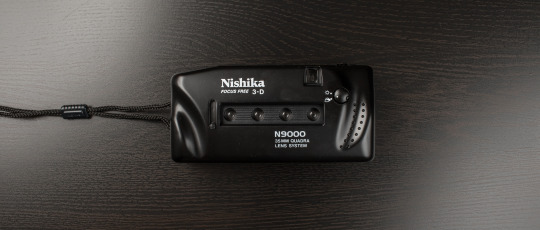
History
The first quad-lens stereo camera was the Nimslo. Designed in the US, the camera was made overseas has solid metal construction, electronically controlled shutter, high quality glass lens and is pretty compact as well. If you read between the lines, you figured $$$. Then came along the N8000, made by a different US company called Nishika, which some claim blatantly knocked off the design idea, made it much cheaper and marketed the living daylights out of it, promising the next big thing in photography. There is much history written about both these companies and why they fell from grace, but that’s not the goal of this review. Both these cameras were originally designed for lenticular mail-order printing where you would take the photos and send the roll in, getting back lenticular prints. In its waning days, Nishika learned on their design mistakes and made the N9000 camera, hoping to renew interest in the franchise, but by that time the infrastructure was starting to fall apart along with the public interest for these items. Nishika went out of business and the overstock was silently decaying in warehouses around the country for decades. Prices went down to near-free and, with the advent of the digital revolution, the camera started seeing a resurgence when experiment-happy photogs figured that these can be used for great artistic effect.

Unboxing & tech specs
Prices bordering in the $10-$20 made this novelty a no-brainer, so I splurged and received a sealed, new-in-box N9000 in the mail not long after. Was a lot of fun opening the package - the whole process resembled an unearthing of a time capsule from a prehistoric age. Best I could tell by the chintzy design and fonts used (I’m an art director by day, I pay attention to these things), my particular specimen was from the early 90’s. The N9000 is made, save from the hotshoe, entirely out of cheap, ready-to-break plastic. Even the lens are plastic. Relatively compact, looks and feels like a beefy, cheeseburger-binging point and shoot. Weighs next to nothing. Small size and weight is a plus for anyone that wants to travel and take multiple cameras for multiple shot types. This one doesn’t take up much space. Each press of the shutter creates 4 tiny half-frame images spread across two regular frames of 35mm film. A 36-exposure roll gets you around 18 shots give or take. A 24-exposure roll probably takes around 12, haven't tried. Has a closable lens cover. Aperture selector between F8 and F16. Button. Rewind button and knob. And winding gear, yes, the winding gear. Reason I want to focus on it is because I genuinely hate it so very much, from the bottom of my usually very accommodating and forgiving heart. They cheaped out and replaced the lever from the N8000 with a finely-sharpened flesh-shearing winding gear to advance each frame and wind the shutter. I can live with it, but I dread every time I have to advance frames. The shutter speed is a fixed 1/60 sec. Has a tripod socket, an unremovable strap, and, well, that’s pretty much it. No batteries. Surprisingly small amount of foam in the back door, so even with vintage, less likelihood of light leaks. Has a little sticker inside recommending 200 film outdoors and 1600 film indoors. I'd personally load it with 400-800 film and tweak exposure with aperture.
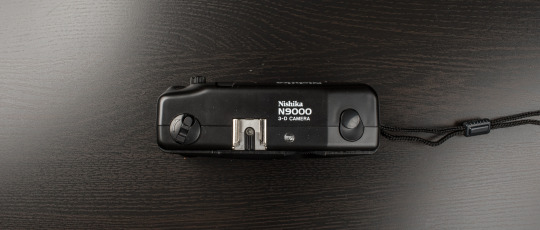
Comparing to the N8000
The main reason I went out on whim and got the N9000 instead of the N8000 is size and weight. As soon as I saw pictures of the N8000 in hand AND read that they put a large chunk of metal inside just to make it feel more expensive and reliable than it is I knew it wasn’t for me, as my photo bags are always packed and space is at a premium. The N8000 is a very, very large camera, I’d say roughly twice the size and weight of the N9000. But, at the same time the picture quality looked to be the same (identical lens) and features are largely identical. The N8000 is also the very definition of gimmicky, with the fake LCD screen on top showing recommended settings for exposure. The "meter" built into it is just there to remind you when to use flash. And with today's film exposure latitude the f/11 is totally redundant. That's a whole lotta strikes out against the N8000. The only feature that I miss from the N8000 is the wind lever instead of gear, the rest of the playing field belongs to the sleeker, more modern and compact N9000. The best camera is the one you have with you, remember?

In use
Load film. Wind to 1. Set aperture. Point. Shoot. That's it. When you get to the end, hit the rewind button and crank that knob. Live life and be happy. They have a rather complicated set of recommendations for ideal positioning of foreground/mid/background elements, but in use I found that they correlate pretty neatly into my shooting style anyway so I just base a shot on instinct and click away. Just frame the subject either medium shot (waist up) to long shot (full figure) and try to compose stuff into the foreground and background for perfect harmony. Even when the rules are totally broken I still notice a 3D effect (works better for objects closer rather than further). When it gets even a little big (very, very little bit) dark - use flash. Theoretically, any type of flash should work, but my Canon 600EX-RT wouldn't trigger because the firing pin is a fraction of an inch off. Go figure. Had to MacGuyver a workaround with a coiled hot shoe extension to make it click. Even then, the flash wouldn't fire every 3-4 frames, killing the shots. Also, some films with a softer base (looking at you, Fuji Superia) tend to be torn at the sprockets when advancing the frame, renderings the entire roll useless. Reason for that is that there is only one film advance cog in the top of the body and winding pressure is applied unfavorably to the top sprocket holes only. Be very, very gently, or bye-bye roll.
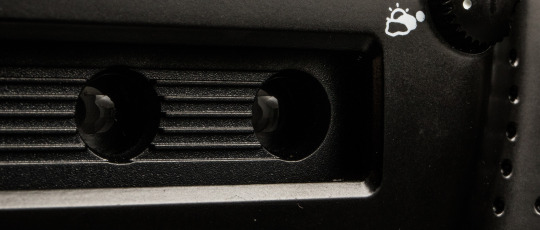
Image processing
After taking the shots, what's next? Everybody has different procedures from here on out but the general goal is to develop the film, get scans and then combine those scans into an animated GIF. If I'm shooting B&W, I develop in my trusty D-76 concoction and after drying, proceed to scan on the Epson V800. Negs are converted in ColorNeg and the final images assembled in Photoshop. Obviously, there are lots of other substeps involved in each respective step, but they are outside the scope of this review. A bit later I am planning to write about my experience with developing your own film, scanning film and using ColorNeg and Lightroom/Photoshop to get the most out of your film shots, but for right now PM me if you would like advice/tips/tricks. Last step is to export an animated GIF or an MP4 video if you're planning on uploading to Instagram. Sounds like a whole lot of steps, huh? No fear, after doing this a couple of times it becomes second nature and many processes can be automated with Actions in photoshop.

Conclussions
So why do it all? Funny thing, I almost filmed a mock camera review where I smash the camera into moon dust against a brick wall. That's how frustrating it sometimes gets with all these inconsistencies and deficiencies in build quality. Would I bring something like this to an even remotely professional shooting environment? Absolutely not. The only camera capable of pulling that off is the Nimslo. Forget anything with a Nishika badge on it. But, if you are looking for a novel (and cheap) way of taking pictures and impressing friends, family and followers, as well as having the technical chops necessary to use film and assemble the GIFs, it's hard to beat the Nishika. The resulting images are what make all of the hassles worth it. It's like I sometimes describe the allure of film in general to people. Film is grainy, soft, full of imperfections and lacks the punch and pizzazz of digital. But oddly enough, that's exactly the way most of our memories work. Warm, somewhat vague,fuzzy. The Nishika just takes it to a new level by introducing depth. It's like a good old memory, animated.
Sample pics
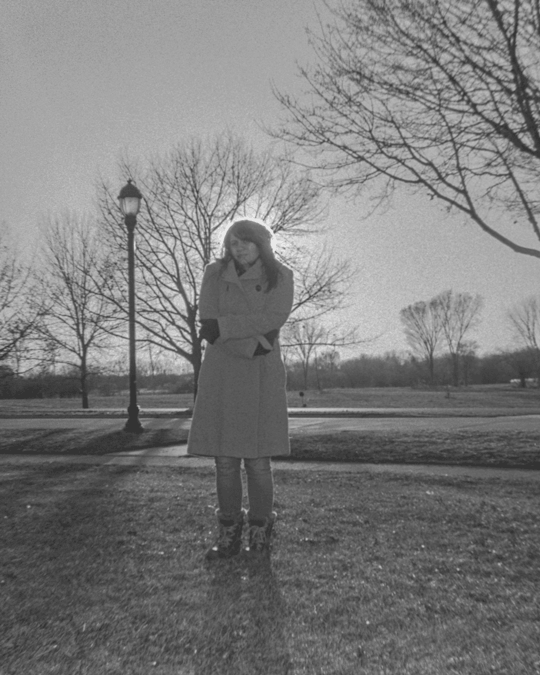
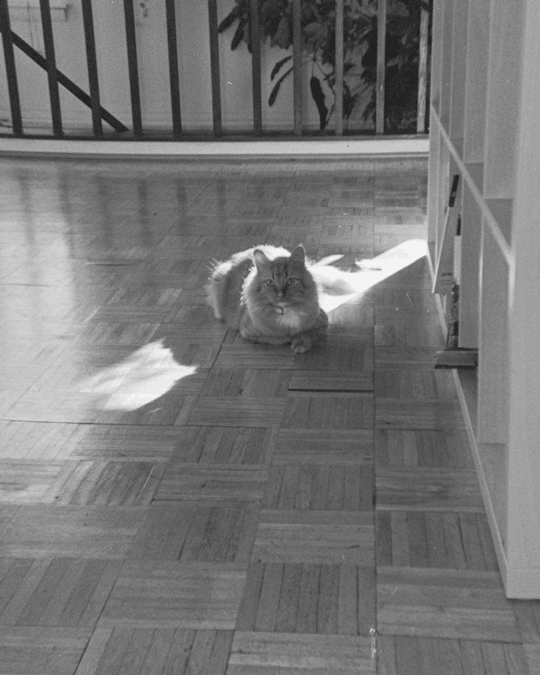
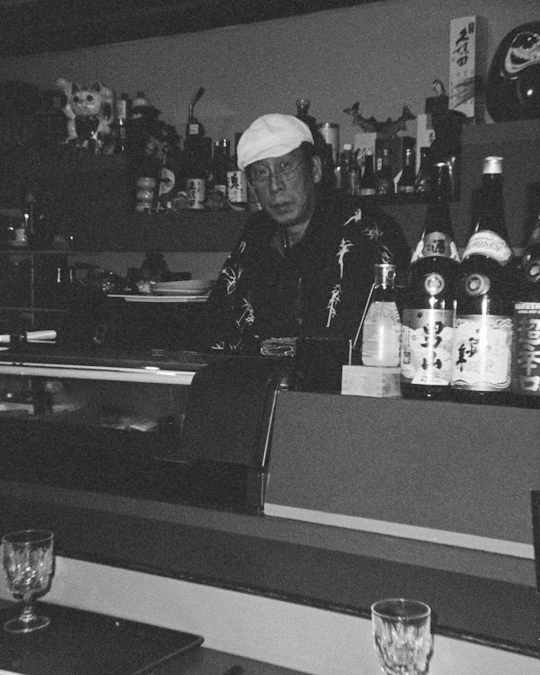

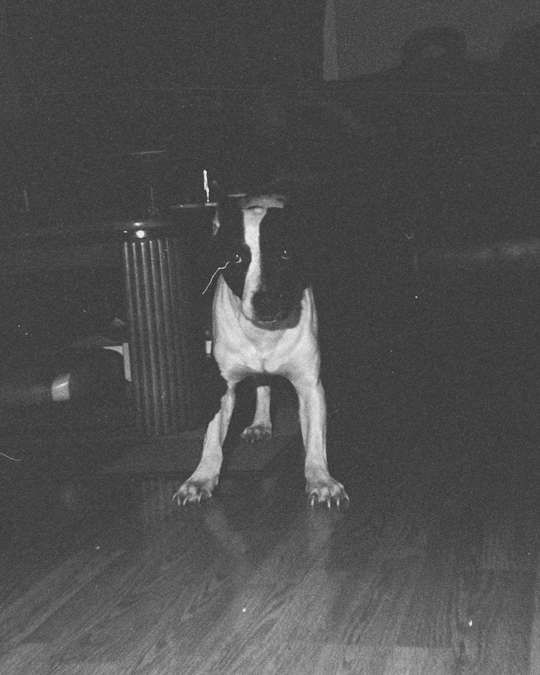
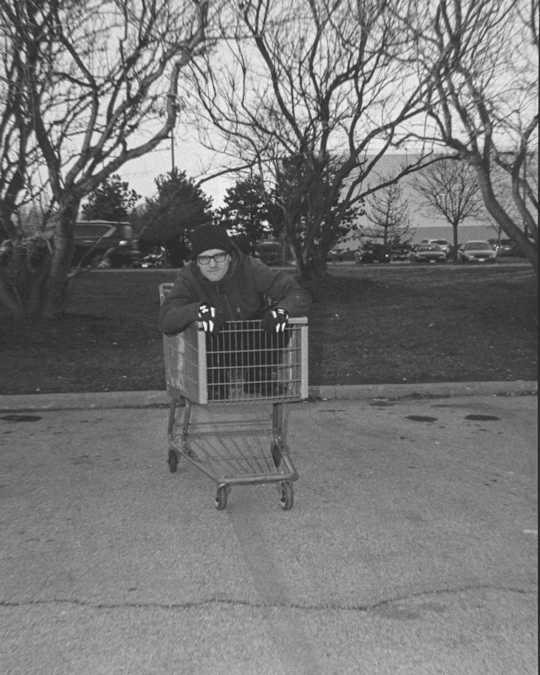
#nishika#film photography#n9000#n8000#camera review#analog#black and white#bw#gif#ilford#hp5 plus#film#35mm#half frame#3d photo#stereo photo#kodak#tri-x#animated memories
1 note
·
View note
Text
0 notes
Text
Insta360 Evo: Now Anyone Can Make Movies for VR
Our verdict of the Insta360 EVO :
Great quality footage for immersive viewing makes this convertible 360/180 stereoscopic device the best way to start making VR movies right now. It's only let down by a non-removable battery and weak plastic clips to lock the position. 910
If you have a VR headset, you’ll know how immersive 180-degree 3D videos can be. But the hardware to produce such videos has been either too pricey or only capable of grainy, low-resolution video. Insta360 EVO changes that. Now you can make beautiful 5.7K resolution 3D, VR180 videos … for less than $500. I’m confident in saying it’s the best consumer-grade camera around for VR moviemaking.
If that wasn’t enough, the convertible design means it can transform back to a 360-degree camera. This gives it the same “shoot now, point later” magical freedom of the Insta360 OneX.
Check out our video review below–preferably on a VR headset if you have one–to find out exactly what we thought of the Insta360 EVO. Nearly all of the review was shot directly on the EVO, so there’s no better way of sampling the footage. And as always, at the end of this review, we’re giving one of these amazing devices away to one lucky reader. Enter using the competition widget at the bottom of the review.
youtube
Insta360 EVO: Specifications and What’s In The Box?
Insta360 EVO Insta360 EVO Buy Now On Amazon $419.99
Insta360 EVO Hybrid 360/180 stereoscopic camera
Mini Tripod
Clip-on phone lenses for previewing videos on your phone
Felt carry case
Max video resolution (combined): 5760×2880 @30FPS
Max photo resolution: 6080×3040
Fixed f2.2 lenses
1200mAh non-removable battery, about 45 minutes continuous shooting
Bluetooth 4.0, micro-USB port
MicroSD storage slot (no card included in the basic set)
I’m not usually one to comment on packaging, but the unboxing experience of the EVO was exquisite. The camera is secured in the box mounted to a large metal stand with a tripod screw from underneath. I’m not sure if this is supposed to serve a later function given the inclusion of a mini tripod, but it’s quite dramatic if you want to keep your device out on display.
Also in our review set was the Holoframe, an accessory for your phone that enables you to view 3D content without the need for a VR headset or special glasses. More on that later.
Convertible Design
You can either use the EVO as a 360-degree camera, with each sensor recording a hemisphere of video; or it can be flipped open to become a stereoscopic 180-degree camera, with sensors recording the left and right eye viewpoint respectively.
When folded, the EVO is a neat little two-inch cube, weighing no more than four ounces. It’s minuscule and extremely easy to carry around.
Swapping between the two modes and locking them back involves some flimsy plastic clips. These seem like they’ll be the first things to break. The buttons to unlock those plastic clips are small and fiddly too. I found myself not actually knowing if it was locked, or halfway in. Just keep it unfolded if you’re unlikely to use the 360-mode.
Controls and indicators on the EVO device itself are sparse: there are two buttons and two LEDs on top, and two LEDs on the front. One button is a dual purpose power and shutter button; the other switches mode between photo and video. The current mode is indicated by one of two LEDs. All of the LEDs flash alternately when recording. There is no menu system or LED panel: any setting beyond photo/video and record/power are done through the app.
The battery is a little larger and therefore lasts longer than the OneX, but on the flip-side it’s non-removable. Still, when shooting for VR, it’s easy to plug the camera into an external power source, since the rear view is invisible (unlike 360-degree videos, where you can’t hide anything).
360-Degree Features Too? Why Would Anyone Buy the OneX Then?
Despite being a convertible design, don’t think this model is a replacement for the OneX device. They do share many of the same features: the core ability to shoot now and point later, automatic removal of the magic selfie stick, TimeShift and FlowState Stabilization, as well as some of the more obscure modes like Tiny Planet. You’ll find all that when shooting in 360-mode on the EVO. I’ve glossed all of this, despite being incredible, because they can all be seen in our Insta360 OneX review.
But two features are noticeably absent. You can’t LiveStream to social platforms, nor can you record Bullet Time sequences. If those were things that really stood out to your from the One X, stick with that. In addition, the lenses are physically further from each other, so the stitching along the horizon may contain more errors. This is a relatively minor gripe, but my point is that if 360-degree shots are your primary intent, buy the OneX instead.
FlowState Stabilization for VR Too
One feature that really differentiates the EVO from competitors is the FlowState Stabilization technology, which gives you ultra-smooth footage by using the onboard gyroscope. This works in both the standard 360-degree mode, as well as 180-degree stereoscopic.
That said: it’s important to remember that most new VR users (and even some experienced ones) will find artificial motion in VR makes them nauseous. It’s a bit like motion sickness, only in reverse. Your eyes perceive movement, but your body isn’t feeling it. For a while, the advice when filming for an intended VR audience was to remain static and simply observe the scene, but this has relaxed a little as most users develop their “VR legs” quickly. Still: know your audience before deciding whether to use camera movement.
If you do intend to move the camera, do it slowly. The FlowState Stabilization certainly helps to smooth things out compared to not having it all.
youtube
Preview the Shot in VR
When previewing something intended for VR on a flat screen, it’s practically impossible to get an idea of scale or presence.
But if you have a Vive Focus, Oculus Go or Oculus Quest, you can preview the footage live through the Insta360 VR app. This is yet another standout feature that sets apart the Insta360 EVO. You can view both the videos already taken and stored on the microSD card, as well as a live viewfinder. You can stream directly from the camera, while you’re shooting. This takes away the guesswork of framing correctly or ensuring objects aren’t too close. There is, of course, a small delay when streaming over Wi-Fi, and you can’t watch at the full resolution.
While it is an incredible feature to have, I didn’t find myself using it to preview shots that much. It was useful for checking out what I’d already recorded, though, and the whole process is about as seamless as it could be. Put on your headset, connect to the camera’s Wi-Fi, open the app. Done.
The Editing Workflow
If there’s one serious drawback to the EVO, it’s the amount of effort required to edit the video. This isn’t a unique problem to the EVO, but it is compounded by such high resolutions!
While the mobile app is perfectly functional for short clips, it’s limited to producing 4K content. For the full quality 5.7K resolution, you’ll need to process the files from the Insta360 Studio desktop app. It took about half a day just to output all the footage I took for the review video, with my MacBook Pro fans running full speed. You’ll also need an enormous hard drive: it works out at about 1 GB per minute.
That’s just to output the raw footage: you’ll need a professional editing suite like Adobe Premiere or Apple Final Cut Pro X to take advantage of 360-degree editing. (Pro-tip: For Final Cut, make sure you select horizontal 360-degree stereoscopic top/bottom as your output format. It’s the last option on the list, and not the default).
After you’re done editing, it will, of course, take longer than usual to render your final video, given such a high resolution.
But you’re not finished yet: for uploading to YouTube and displaying it as a VR180 video, you’ll need to use Google’s free VR180 Creator tool to inject the required metadata. Otherwise, YouTube doesn’t know it’s designed for VR, and will just try to compress it to a regular viewing window.
In short, it took an inordinate amount of time to process, edit, render, inject metadata, then upload the 15 GB review video you see embedded!
You’ll need a powerful machine, a big hard disk, an unlimited internet connection, and a mountain of patience. I should note that there is apparently a more direct integration with Adobe Premiere, but I don’t have that to test with.
The Holoframe and Clip-on Glasses
The Holoframe looks like a regular gel phone case, and is designed to be used as one when you’re not previewing videos. When you do want to use it, just snap it off the back and clip it onto the front of your phone instead. It works in a similar way to other glasses-less lenticular screens, but uses the phone’s front camera to see where your eyes are and adjust the 3D effect accordingly. Previous attempts at glasses-less 3D viewing through lenticular screens required you to sit in a particular place; the Holoframe uses the phone’s processing to adjust the image, rather than you needing to adjust your seat. If you want this, you’ll need to buy the model that matches your phone. Only a handful of the latest handsets are supported.
It works, but the 3D effect was overall unsatisfying, I felt.
In fact, I preferred the stereo separation and depth offered with the included clip-on 3D viewing glasses, which work with any phone.
Moreover, use of the Holoframe requires a scene to be processed before you can watch it. The processing time depends on the length of the clip, but even a relatively short clip will take a minute or so. And if you move your eyes, the app will need to “capture” where they are before you can resume watching. It just felt like far more effort than it was worth. The clip-on glasses could be used without any additional processing time: it’s just a generic side-by-side 3D output.
Should You Buy an Insta360 EVO?
The main attraction of the EVO is the ability to shoot for VR. If you’re not sure you even want to do that, and are primarily interested in the 360-degree features, go for the OneX model instead. You’ll get better quality stitching, a removable battery, and a few other features like the ability to shoot bullet-time that aren’t found on this device. Consider the EVO mainly for VR video production, with 360 features as a little bonus.
Insta360 EVO Insta360 EVO Buy Now On Amazon $419.99
The hardware isn’t perfect. The non-removable battery and flimsy plastic clips are annoying, but not enough to detract from the overall fantastic package on offer here. Finally, it’s feasible for everyone to produce good quality VR video content.
Just don’t bother with the Holoframe. The included clip-on glasses are fine for previews on your phone. For the ultimate live VR preview, put on your Oculus Go or Quest!
Enter the Competition!
Insta360 EVO VR180/360 Convertible Camera Giveaway
Read the full article: Insta360 Evo: Now Anyone Can Make Movies for VR
Insta360 Evo: Now Anyone Can Make Movies for VR published first on http://droneseco.tumblr.com/
0 notes